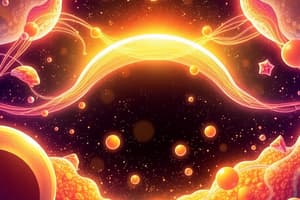Podcast
Questions and Answers
What is the basic chemical formula for carbohydrates?
What is the basic chemical formula for carbohydrates?
(CH₂O)n
What are the four main classifications of carbohydrates?
What are the four main classifications of carbohydrates?
- Sugars, Starches, Fibers, Glycogen
- Simple, Complex, Soluble, Insoluble
- Monosaccharides, Disaccharides, Oligosaccharides, Polysaccharides (correct)
- Aldoses, Keotses, Pyranoses, Furanoses
The simplest aldose is ______.
The simplest aldose is ______.
D-glyceraldehyde
What is the name given to the six-membered ring form of glucose?
What is the name given to the six-membered ring form of glucose?
Match the disaccharide with its primary source or function:
Match the disaccharide with its primary source or function:
Cellulose is a major component of plant cell walls and is easily digestible by humans.
Cellulose is a major component of plant cell walls and is easily digestible by humans.
What is the name given to the storage form of glucose in animals?
What is the name given to the storage form of glucose in animals?
Sucrose, a disaccharide, is a reducing sugar.
Sucrose, a disaccharide, is a reducing sugar.
What is the process called that joins two monosaccharides together to form a disaccharide?
What is the process called that joins two monosaccharides together to form a disaccharide?
Flashcards
What are carbohydrates?
What are carbohydrates?
Polyhydroxyaldehydes or polyhydroxyketones, or compounds that yield them upon hydrolysis. They are also known as sugars or saccharides.
What are monosaccharides?
What are monosaccharides?
Carbohydrates that cannot be broken down into simpler units by hydrolysis. Examples include glucose and fructose.
What are disaccharides?
What are disaccharides?
Carbohydrates that can be hydrolyzed into two monosaccharide units. Examples include sucrose, lactose, and maltose.
What are oligosaccharides?
What are oligosaccharides?
Signup and view all the flashcards
What are polysaccharides?
What are polysaccharides?
Signup and view all the flashcards
What is a monosaccharide?
What is a monosaccharide?
Signup and view all the flashcards
What are aldoses?
What are aldoses?
Signup and view all the flashcards
What are ketoses?
What are ketoses?
Signup and view all the flashcards
What is a chiral carbon?
What is a chiral carbon?
Signup and view all the flashcards
What are enantiomers?
What are enantiomers?
Signup and view all the flashcards
What are epimers?
What are epimers?
Signup and view all the flashcards
What is a Fischer projection?
What is a Fischer projection?
Signup and view all the flashcards
What is a Haworth projection?
What is a Haworth projection?
Signup and view all the flashcards
What are anomers?
What are anomers?
Signup and view all the flashcards
What is an (1→4) glycosidic linkage?
What is an (1→4) glycosidic linkage?
Signup and view all the flashcards
What is starch?
What is starch?
Signup and view all the flashcards
What is amylose?
What is amylose?
Signup and view all the flashcards
What is amylopectin?
What is amylopectin?
Signup and view all the flashcards
What is glycogen?
What is glycogen?
Signup and view all the flashcards
What is cellulose?
What is cellulose?
Signup and view all the flashcards
What is maltose?
What is maltose?
Signup and view all the flashcards
What is sucrose?
What is sucrose?
Signup and view all the flashcards
What is lactose?
What is lactose?
Signup and view all the flashcards
What is dehydration synthesis?
What is dehydration synthesis?
Signup and view all the flashcards
What is a β(1→4) glycosidic linkage?
What is a β(1→4) glycosidic linkage?
Signup and view all the flashcards
What are reducing sugars?
What are reducing sugars?
Signup and view all the flashcards
What are non-reducing sugars?
What are non-reducing sugars?
Signup and view all the flashcards
What is the osazone formation reaction?
What is the osazone formation reaction?
Signup and view all the flashcards
What are amino sugars?
What are amino sugars?
Signup and view all the flashcards
Study Notes
Carbohydrates
- Carbohydrates are polyhydroxy aldehydes or ketones, or compounds that yield these on hydrolysis.
- They are sources of energy, intermediates in the biosynthesis of other biochemical entities (fats and proteins), associated with other entities such as glycosides, vitamins, and antibiotics), form structural tissues in plants and microorganisms (cellulose, lignin, murein), and participate in biological transport, cell-cell recognition, activation of growth factors, and modulation of the immune system.
- Glucose provides energy for the brain and half of the energy for muscles and tissues. Glycogen is stored glucose, which is the immediate energy, while glycogen is the reserve energy.
- Carbohydrates have a general formula (CH₂O)n, where n = 3, 5, or 6.
- Carbohydrates can be classified as monosaccharides, disaccharides, oligosaccharides, and polysaccharides.
- Monosaccharides are simple sugars that cannot be hydrolyzed into simpler sugars (examples include glucose and fructose).
- Disaccharides are carbohydrates that can be hydrolyzed into two monosaccharide units (examples include sucrose, which hydrolyzes into glucose and fructose).
- Oligosaccharides can be hydrolyzed into a few monosaccharide units.
- Polysaccharides are polymeric sugars like starch and cellulose.
- Aldoses have an aldehyde group at one end (like glucose).
- Ketoses have a keto group, typically at C-2 (like fructose).
- Most naturally occurring sugars are D isomers.
- Enantiomers are mirror images of one another.
Molecular Construction of Glucose
- Glucose has a chemical formula of C₆H₁₂O₆.
- Glucose is a six-sided ring.
- A simplified structure of glucose is depicted.
Classification of Carbohydrates
- Carbohydrates are polyhydroxy aldehydes or ketones or compounds that yield these on hydrolysis.
- Monosaccharides are simple sugars that cannot be hydrolyzed. (e.g. glucose or fructose)
- Disaccharides are carbohydrate that can be hydrolyzed into two monosaccharides (e.g sucrose which hydrolyzes into glucose and fructose)
- Oligosaccharides can be hydrolyzed into a few monosaccharide units.
- Polysaccharides are polymeric sugars (e.g Starch or cellulose).
Characteristics of Carbohydrates
- Carbohydrates are composed of carbon, hydrogen, and oxygen.
- They are energy-containing molecules.
- Some carbohydrates provide structure.
- The basic building block is a monosaccharide (CH₂O)n, where n= 3, 5, or 6..
- Two monosaccharides form a disaccharide.
Monosaccharides
- Monosaccharides are also known as simple sugars.
- They are classified by the number of carbons and whether they are aldoses or ketoses.
- Most monosaccharides are straight-chain compounds.
- D-glyceraldehyde is the simplest aldose (aldotriose).
- Other sugars end in "ose" (e.g., glucose, galactose, ribose, lactose).
Glucose Structure
- The chemical formula is C₆H₁₂O₆.
- It has a six-sided ring structure and simplified representation.
Relative Sweetness of Different Sugars
- Sucrose has a relative sweetness of 100.
- Glucose has a relative sweetness of 74.
- Fructose has a relative sweetness of 174.
- Lactose has a relative sweetness of 16.
- Invert sugar has a relative sweetness of 126.
- Maltose has a relative sweetness of 32.
- Galactose has a relative sweetness of 32.
D & L Designation
- D and L designations are based on the configuration about a single asymmetric carbon in glyceraldehyde.
- The lower representations are Fisher Projections.
Enantiomers
- Enantiomers are a special type of isomerism found in pairs, are mirror images of each other, and are designated as D- and L-sugars.
- If two monosaccharides differ in configuration only around one specific carbon atom (excluding the carbonyl carbon) they are epimers.
(+)-glucose
- (+)-glucose is also known as an aldohexose.
- Emil Fischer (1902) is recognized for the work on this carbohydrate.
- There are four chiral centers, and 24 = 16 stereoisomers.
Fructose
- Fructose can form a 6-membered pyranose ring by reacting the C2 keto group with the OH on C6.
- It also forms a 5-membered furanose ring by reacting the C2 keto group with OH on C5.
Epimers
- Epimers are stereoisomers differing only in configuration around one chiral center.
- Examples of sugars can be compared/contrasted in relation to this concept.
Hemiacetal & Hemiketal formation
- An aldehyde can react with an alcohol to form a hemiacetal.
- A ketone can react with an alcohol to form a hemiketal.
Anomers
- Anomers are stereoisomers formed when a ring is formed (α, β).
- α is same side with ring.
Rules for drawing Haworth projections
- For D-sugars the highest numbered carbon is drawn up.
- For L-sugars it is drawn down.
- For D-sugars, the OH group at the anomeric position is drawn down for α and up for β.
- For L-sugars, α is up and β is down.
Pentoses and Hexoses
- Pentoses and hexoses can cyclize when the ketone or aldehyde reacts with a remote OH.
- Glucose forms an intra-molecular hemiacetal.
D-glucose
- D-glucose can cyclize in two ways, forming either furanose or pyranose structures.
D-ribose
- D-ribose and other five-carbon saccharides form either furanose or pyranose structures.
Structural representation of sugars
- Fisher projection: straight-chain representation.
- Haworth projection: simple ring in perspective.
- Conformational representation: chair and boat configurations.
Different Forms of Glucose
- Different forms of glucose are represented.
2-Deoxyribose
- Oxygen of the hydroxyl is removed to form deoxy sugars.
- Non reducing and non osazone forming.
- Important part of nucleic acids.
Simple Carbs
- Monosaccharides are all 6-carbon hexoses.
- They have 6 carbons, 12 hydrogens, and 6 oxygens.
- Arrangement of the oxygen atoms differentiate types of sugars.
Three Monosaccharides
- Glucose, galactose, and fructose are shown as examples of monosaccharides.
- They share the formula C₆H₁₂O₆.
α and β Hemiacetal / Hemiketal
- α- and β- examples are shown for hemiacetals and hemiketals of D-glucopyranoses.
α and β Furanose / Hemiacetal
- α- and β- examples of furanose forms are shown for (D-glucofuranoses).
Optical Activity
- Dextrorotatory (+) if the sugar solution turns the plane of polarized light to the right.
- Levorotatory (-) if the sugar solution turns the plane of polarized light to the left.
- Racemic mixture has no net rotation if the mixture is composed of equal amounts of the enantiomers.
Glycosidic Bonds
- The anomeric hydroxyl and another sugar/compound hydroxyl join together by the splitting of water to form a glycosidic bond.
- Example: Methanol reacts with the anomeric OH on glucose to form methyl glucoside.
Methyl-D-glucoside
- Anomeric forms of methyl-D-glucoside are illustrated.
Sugar Derivatives
- An amino group substitutes for a hydroxyl group forming an amino sugar.
- Example of an amino sugar is Glucosamine.
- Amino groups can be acetylated (acetylglucosamine).
Disaccharides
- Maltose is a cleavage product of starch.
- It has an α(1→4) glycosidic link between the C1 and C4 OHs of 2 glucoses.
- Cellobiose is a product of cellulose breakdown, but otherwise similar/equivalent to the β anomer (O on C1 points up).
- The β(1→4) glycosidic linkage zig-zags, but one glucose is flipped over compared to the other.
Maltose
- Malt sugar is formed during starch digestion, and is composed of two a-D-glucose units linked via an alpha(1,4) glycosidic bond.
Other Disaccharides
- Sucrose is common table sugar with an α(1→2) glycosidic bond linking the anomeric hydroxyls of glucose and fructose.
- Lactose, milk sugar, includes galactose and glucose linked via a β(1→4) glycosidic bond.
Sucrose
- Sucrose is cane or table sugar. α-D-glucose and β-D-fructose linked by (α1-β2) bond.
- The reducing groups of its constituents are involved in bond formation, and thus is considered non-reducing. This is illustrated by drawings of sucrose.
Lactose
- Lactose is the principle sugar in milk.
- β-D-galactose and β-D-glucose are linked by a beta (1,4) glycosidic bond.
Reducing and Non-reducing Sugars
- Reducing sugars have a free aldehyde or keto group which can be oxidized. Examples are Maltose and Lactose.
- Non-reducing sugars do not have a free aldehyde or keto group. Examples are Sucrose and Trehalose.
Invert Sugar
- Invert sugar is formed when sucrose in solution changes rotation from dextrorotatory (+) to levorotatory (-).
- This change indicates that sucrose has been hydrolyzed into glucose and fructose.
Dehydration Synthesis of a Disaccharide
- Illustrated is the dehydration synthesis reaction of Glucose and Fructose to produce Sucrose. Water is a byproduct.
Formation of Disaccharides
- Illustrated are the condensation reactions of Glucose and Glucose to form Maltose; Galactose and Glucose to form Lactose; and some chemical structures of Maltose and Lactose.
Starches
- Starches are stored in plant cells.
- The body hydrolyzes plant starch into glucose.
Starch
- Starch is the most common storage polysaccharide in plants.
- It is composed of 10 - 30% amylose and 70 - 90% amylopectin (depending on the source).
- Starch chains have varying lengths, with molecular weights ranging from several thousands to half a million.
Polysaccharides
- Plants store glucose as amylose or amylopectin, which are collectively called starch.
- Glucose storage in a polymeric form minimizes osmotic effects.
- Amylose is a glucose polymer with α(1→4) linkages. The reducing end of the polysaccharide is the end with an anomeric carbon not involved in a glycosidic bond.
- Amylopectin is a glucose polymer mainly with α(1→4) linkages, but also having α(1→6) linkages, with branches.
Amylose and Amylopectin
- Amylose and amylopectin are two forms of starch.
- Amylopectin has a highly branched structure, with branches occurring every 12 - 30 residues.
Cellulose
- Cellulose is a polymer of β-D-glucose with β(1→4) linkages.
- It is a structural polysaccharide, only digested by ruminants.
- Partial hydrolysis of cellulose yields cellobiose.
- It has a cotton flax content of 97-99% and is ~ 50% of wood.
- Cellulose is insoluble in water.
- Cellulose gives no color with iodine.
- Cellulose is held together with lignin in woody plant tissues.
Glycogen
- Glycogen is the glucose storage polymer in animals, and is similar to amylopectin.
- Glycogen has more α(1→6) branches.
- The highly branched structure permits rapid glucose release from glycogen stores (e.g. in muscle during exercise). Rapid glucose mobilization is more essential for animals than plants.
- Glycogen and iodine give a red-violet color.
- It's hydrolyzed by α and β-amylases and glycogen phosphorylase.
Special Monosaccharides: Amino Sugars
- Monosaccharides, such as glucosamine and galactosamine, include amino groups replacing hydroxyl groups. These are constituents of mucopolysaccharides.
Studying That Suits You
Use AI to generate personalized quizzes and flashcards to suit your learning preferences.




